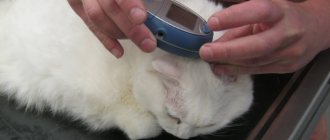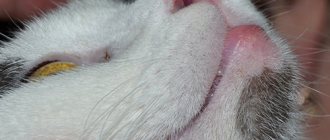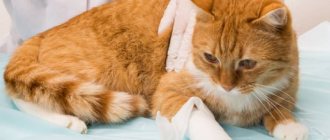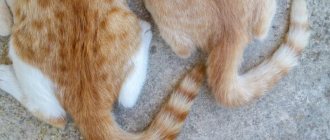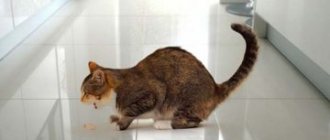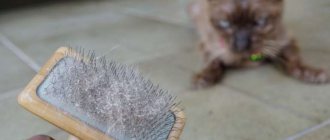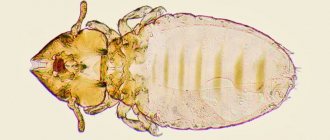Learn today about the symptoms and signs of diabetes in indoor cats. How to diagnose and treat.
Diabetes mellitus in cats is a chronic metabolic disease characterized by the inability of the animal's body to produce sufficient amounts of insulin. Insulin is a hormone responsible for balanced levels of sugar (glucose) in the blood. If the blood sugar level rises critically (hyperglycemia), this negatively affects the condition of all organs and systems.
In this material we will tell you why diabetes mellitus occurs in cats, what it is like, how it manifests itself, how it is treated, diet and whether it can be prevented.
Prevention
To prevent diabetes from progressing in cats, simple preventive measures are required:
- There is no need to overfeed your pet, even if he walks around with hungry eyes.
- The amount of carbohydrates consumed should be minimal.
- You cannot feed him only meat and fish, especially raw ones.
- The cat should not be fed sweets.
- It is necessary to give your cat some exercise, especially for those who like to lie on the sofa.
- When buying a cat, it would be a good idea to ask the pet’s parents if there were similar signs of disease in the family.
- Regular consultations with a veterinarian can help identify the first symptoms of diabetes.
- Any medications should be given only with the recommendation of a veterinarian.
Risk group
Diabetes in cats is considered to be the most common disease of the endocrine system. The risk group includes:
- Most often, symptoms of diabetes are observed in an elderly cat.
- In cats, signs of this disease are more common than in cats. Moreover, they suffer from it more often, since they are more susceptible to obesity.
- Signs of diabetes are also observed in sterilized cats.
- A cat that is 1.5 kilograms overweight is more likely to be diagnosed with diabetes. An animal that weighs more than 6 kilograms automatically falls into the risk group for type 2 diabetes.
Diabetes in a cat is not a death sentence
It is important to notice the first symptoms of the disease in time and begin timely treatment. Many cats with proper care for this disease live a long time and delight their owners with excellent health and appearance.
In the directory of cat diseases you can find many ailments with completely “human names” (for example, cats suffer). Does this mean that cats get our diseases? Veterinarians say yes. Moreover, in recent years there has been a trend where signs of terrible illnesses similar to human ones are found among cats more and more often.
So, for example, if we take such a terrible disease as diabetes, then although it used to be less common in cats than, for example, in dogs, today such a diagnosis is given not to every 400 cats, but to every 350...
About diabetes in cats, its symptoms, causes and, of course, how to treat a cat and how to help it
– we invite you to talk about all this on the pages of our new publication...
Diabetes mellitus: features and treatment
Diabetes mellitus is a chronic disease caused by a deficiency of the hormone insulin. It is characterized by a disruption of metabolic processes in the body and is manifested by an increase in blood sugar levels, damage to blood vessels, important organs and systems.
In cats, diabetes mellitus is most often diagnosed after 5 years of age and manifests itself:
- violation of carbohydrate metabolism;
- progressive increase in blood sugar levels;
- excretion of sugar in the urine.
Predisposing factors of pathology are:
- hormonal disorders;
- hereditary predisposition;
- severe infectious signs;
- some systemic diseases.
There are two types of diabetes in cats:
- Type I (insulin dependent) – develops in animals even at a young age due to reduced insulin production, treated only with lifelong insulin injections;
- Type II (insulin-independent) – diagnosed in animals in middle and older age, characterized by insufficient insulin production, therapy involves taking glucose-lowering drugs.
Before drawing up a treatment regimen, clinical examinations of the animal are carried out - every 2-3 hours, blood is taken for analysis and an insulin curve is compiled. Based on the obtained indicators, maintenance doses of insulin or glucose-lowering drugs are calculated, which can reduce glucose levels to 5.5-10 mmol/l. The primary dose of insulin is 0.5-1 units/kg of animal body weight.
Diabetes mellitus can cause health complications in cats:
- cataract;
- diabetic retinopathy – a vascular disease of the eyes;
- trophic skin lesions localized on the face, tips of the ears, and limbs.
Diabetes mellitus is not a death sentence if you notice the symptoms of the disease in time and are attentive to treatment. Strict adherence to the veterinarian's recommendations will extend your pet's life for many years.
Cats with diabetes require a special diet - it is better to exclude natural food and use only specialized medicinal food that contains the required amount of fiber and carbohydrates. The diet will help you avoid sudden spikes in sugar. If there are minor changes in your glucose levels, you may not need to take medications.
source
Recommendations for prevention
Prevention of hypoglycemia and hyperglycemia requires a certain diet:
- Eat more natural foods and avoid ready-made meals that are rich in trans fats;
- Avoid foods that overload the liver;
- Eat more fiber;
- In case of hypoglycemia, eat a large amount of protein foods.
If the disease is secondary, then it is necessary to simultaneously treat the underlying disease that caused hypoglycemia or hyperglycemia.
Diseases that provoke deviations from normal blood glucose:
- Liver pathology - hepatitis;
- Liver disease - cirrhosis;
- Oncological neoplasms in liver cells;
- Pathology in the functionality of the pituitary gland;
- Disorders of the pancreas.
A healthy lifestyle plays a huge role in preventing blood glucose abnormalities. Bad habits, stressful situations, overload of the body, negatively affect both the increase in sugar and its decrease.
If you regularly follow these rules, you can protect yourself from a sharp drop in blood sugar.
- You need to eat small meals often. It's best if it's three main meals and two snacks. The basis is nutritious protein foods, snacks - fruits, juices.
- You can't skip breakfast. During sleep, sugar levels decrease, so in the morning you need to replenish it with food.
- It is better to exclude simple carbohydrates from the diet - flour, white bread, confectionery, carbonated drinks, beer.
- The basis of the diet should be fiber and complex carbohydrates.
- It is worth minimizing your coffee consumption. Caffeine stimulates insulin production.
- Smoking has a negative effect on glucose levels, so if you have diabetes, you should stop smoking.
- Regular meals including foods containing omega 3 in the menu will prevent sugar levels from falling below normal. This amino acid is found in seafood, fish, olive and sesame oil, and raw pumpkin seeds.
- The chromium element helps maintain normal glucose levels. It is found in cheese, nuts, seed sprouts, fresh fruits and vegetables. Therefore, the consumption of these products should be regular.
- If hypoglycemic manifestations do occur, you must always have sweets with you that will help quickly raise your glucose. It could be a piece of candy, a bar of chocolate, or just a piece of sugar.
How to take blood from a cat to test for sugar?
The most convenient way to collect blood from a cat is from the auricle. To see the vessels, the ear is illuminated with a flashlight. Before taking blood, you cannot disinfect your ear!
Blood can also be taken from the paw pads.
- Use any medical or veterinary blood glucose meter.
- Turn on the glucometer and insert a test strip into it.
- Pierce the ear or paw pad with a needle. Wait for a drop of blood to appear, then apply the test strip to the drop of blood.
- Insert the strip into the glucometer and wait for the result.
- Treat the puncture site with chlorhexidine.
Tip: If blood spreads across the ear, shave it or lubricate the fur with a thin layer of Vaseline.
Cat with diabetes: instructions for use
If your beloved cat has been diagnosed with diabetes, there is no need to despair. In the absence of concomitant pathologies and timely treatment, the prognosis is favorable and it is possible to prolong the life of the animal as much as possible with the best quality. This will require you to inject insulin 2 times a day and periodically measure your blood glucose levels on your own or in a clinic setting.
How to measure sugar yourself?
It is convenient for cats to measure blood sugar by drawing blood from the vessels of the auricle. In order to see these vessels, you can shine a flashlight into your ear or shave the edges of your ears. Before taking blood, the ear cannot be treated with disinfectant solutions.
In addition, blood can be taken from the paw pads.
1. Use any medical or veterinary blood glucose meter. We use Accu-Chek Active and the corresponding strips.
2. First turn on the meter by inserting a strip into it. Check that the code on the strip package matches the code on the meter screen. Wait for the drop icon to appear.
3. Take a needle with a diameter of 21-23 G (blue, green cannula) or a lancing pen from a glucometer.
4. Pierce the vessel and wait for a drop to appear; apply a strip to the drop of blood. The blood will be absorbed.
5. Insert the strip into the glucometer and wait for the result.
6. Treat the puncture site with chlorhexidine, or hydrogen peroxide, or 50-70% alcohol. If the blood spreads throughout the fur and is difficult to collect, it is better to shave the ear or lubricate the fur with a thin layer of Vaseline.
Insulin
At the beginning of treatment, the dose of insulin is selected. We prescribe Caninsulin, a long-acting insulin (administered 2 times a day, with less frequent injections for the convenience of owners). The dose is always individual and depends on the weight of the animal and the needs of its body.
Caninsulin is a veterinary drug and is sold in veterinary pharmacies and clinics.
The method of administration - subcutaneous or intramuscular - is selected by the doctor. Since there are often some difficulties with purchasing insulin in pharmacies, it is recommended to always have one spare sealed package of insulin at home.
It is usually recommended to throw away an opened package of insulin after 1.5-2 months, even if it is not completely used up. Insulin syringes can be purchased at a medical pharmacy or in our clinic.
Syringes come with graduations of 100 units and 40 units per 1 ml (in Kaninsulin 40 units per 1 ml). Be sure to pay attention to how much insulin occupies in the syringe and the presence of air in the syringe.
The insulin vial should be stored in the refrigerator; before taking the drug, the vial must be carefully turned over several times (without shaking).
The collected amount can be warmed in your hand. When selecting insulin, it is necessary to measure blood glucose on days 3-4 (preferably 2 days in a row) 3 times a day (necessarily on an empty stomach! 3-4 hours without feeding): 1. before the morning administration of insulin; 2. 6 hours after insulin administration; 3. before evening insulin administration
Based on the measurement results, insulin levels are adjusted:
- - if the sugar level is 6-16 mmol/l - the same dose;
- - more than 16 mmol/l - dose increase by 25%.
- - less than 10 mmol/l - skip the injection and reduce the dose by 25%;
- - less than 5 mmol/l (before administering insulin), skip the injection, reduce the dose by 50%.
It is better to call your veterinarian to adjust the dose. If the dose was changed, then the next measurements will be made again after 3-4 days; if the dose is maintained, control will be taken after 1 week.
If the condition and dose level are stable, further control sugar every 2-3 weeks for life. It is advisable for one person in the family to treat the animal.
Caution, hypoglycemia!
Hypoglycemia is a drop in glucose levels below the required level.
Symptoms: anxiety or, on the contrary, apathy, increased hunger, trembling, convulsions, and with very low sugar - loss of consciousness, coma. When such symptoms appear, if the animal is conscious, it is necessary to feed it and/or drink sweet syrup (sugar, honey, glucose with water) and take it to the clinic.
If the animal is unconscious, then the syrup should be rubbed into the gums and the animal should be taken to the clinic. It is important to remember that the effects of too much blood glucose affect the body gradually, while a drop in blood glucose below normal levels (hypoglycemia) can be fatal very quickly. For this reason, it is not as scary to “underdose” insulin as to overdose it.
Therefore, if you injected insulin, but were not sure that you were in the right place (for example, you felt that the fur became wet at the injection site), or you do not know whether someone at home injected insulin before you, never re-inject insulin. It is better to miss an injection once than to inject twice by mistake.
Body mass
Overweight animals need to reduce it, because... obesity reduces the sensitivity of cells to insulin, which means it worsens diabetes.
In some overweight diabetic cats, it was possible to avoid insulin and just follow the diet after weight loss.
In animals with normal weight, it is necessary to maintain it within these limits. If the animal is underweight, then it is necessary for the cat’s weight to increase to normal.
Your veterinarian will tell you the optimal body weight.
Diet
Usually, immediately after a meal, glucose in the blood increases very strongly, and the body of a diabetic animal cannot cope with such a load. Therefore, the point of feeding for diabetes is to ensure that the flow of glucose from food into the blood is as slow as possible. This is usually achieved by selecting special sources of dietary fiber in the right proportion. In addition, the food must contain a limited amount of calories and a sufficient amount of protein. The best solution is to feed with special medicated food (Hill's w/d, Royal Canin Diabetic, Purina DM, etc.).
If for any reason this is not possible, you should discuss other options with your doctor. The frequency and time of feeding are selected individually, but the cat must eat at the hour when insulin is set. If there are concomitant diseases, such as renal failure, there may be contraindications for diabetic feeds. In this case, the veterinarian will select an appropriate diet for your pet.
As for the amount of food consumed per day, it is very important to feed the animal in such quantities that it remains thin. Obesity reduces the sensitivity of cells to insulin, which means it worsens diabetes. With a stable weight, the amount of coma daily should be the same. If you do not comply with the norm, there will be a difference in insulin consumption and there may be sharp jumps in blood glucose.
Physical exercise
Physical activity reduces the need for insulin due to the active consumption of glucose by muscles, and also helps maintain normal body constitution. Physical activity should be moderate, be sure to be regular, and its dose should not change.
The increase in load should be very gentle and gradual.
Not all cats lead an active lifestyle.
In order to make the cat move, you can use special toys (balls, fishing rods and other products are available in a wide range in pet stores). It is convenient to use laser pointers. In addition, you can place the bowl on a hill or on top of special houses: the cat must make an effort to get to the food.
Good luck in maintaining your pet's health!
Our doctors are always ready to answer all your questions!
Sincerely, the team of the clinic “Klyk”, Perm!
Treatment of diabetes in cats
Treatment of diabetes mellitus in cats is prescribed depending on the type and severity of the animal’s condition. The treatment regimen is comprehensive and includes the following main activities:
- Glycemic control. Restoring normal blood sugar levels.
- Normalization of weight. Eliminate signs of weight loss.
- Normalization of appetite.
- Elimination of thirst and frequent urination.
Adjusting the diet and introducing a special diet is a mandatory part of treatment.
For animals that are in satisfactory condition, the doctor selects the type of insulin, its dosage form (injections or tablets), dose and frequency of administration.
If an animal has ketoacidosis, a condition in which cells without glucose break down fats for energy, infusion therapy (intravenous drug administration) using short-acting insulin is necessary. Animals with ketoacidosis may require hospital treatment at a veterinary clinic.
After the condition has stabilized, it is possible that the doctor will advise the cat to have the ovaries and uterus removed, since it is difficult to control blood glucose levels during the animal’s sexual activity.
Depending on the type of insulin and the frequency of its administration, the frequency and feeding regimen may have to be changed. Giving up your usual food and switching to a special diet must be done gradually. Read the article on how to choose cat food.
The prognosis for an animal with diabetes is favorable, provided that all the doctor’s instructions are strictly followed - regular administration of medications, monitoring blood glucose levels, diet.
Insulin therapy
The basis of diabetes treatment is insulin therapy. For type I diabetes, short-acting insulin drugs are prescribed. For type II disease, medium- or long-acting insulin or glucose-lowering tablets are used.
Injectable insulin is used to treat cats. Oral hypoglycemic drugs do not control diabetes in animals well. Owners of cats with diabetes will have to learn how to give insulin injections. This shouldn't be scary. Over time, most owners get used to regular injections, which are vital for their sick pets.
How to properly give an insulin injection to a cat
It is best to inject insulin preparations into the side of the animal, since the skin there is thinner than at the withers. The animal will practically not feel the injection. This makes it easier to pierce the skin and make sure that the entire dose gets under the skin.
Video - how to give a subcutaneous insulin injection to a cat
Diabetes drugs
- Caninsulin is an aqueous suspension for injection based on purified porcine insulin. The dosage and frequency of administration are calculated by the veterinarian individually for each animal. You cannot change the dosage yourself. Price: 305 rub./190 UAH.
- Miglitol. The tablets slow down the absorption of glucose, thereby lowering blood sugar levels. The dosage is calculated individually for each cat by a veterinarian. Prescribed for type II diabetes. Price: 900 rub./287 UAH.
- Metformin. A hypoglycemic drug for the treatment of type II diabetes. Prescribed to obese cats. The dosage is calculated individually. Price: 93 RUR/25 UAH.
- Minidiab (Glipizide). Tablets to lower blood sugar levels. Prescribed if there is no effect from a low-carbohydrate diet for type II diabetes. Price: 2750 rub./660 UAH.
- Glyurenorm (Gliquidone). Sugar-lowering tablets for the treatment of type II diabetes. Price: 390 rub./252 UAH.
How to control your cat's sugar levels
To do this, use special test strips (to determine the level of sugar in the urine) and veterinary glucometers (to determine the level of glucose in the blood).
To use a test strip to measure the amount of glucose in your urine, simply dip the strip into your cat's waste.
How to correctly take a blood test with a glucometer from a cat
For animals, choose a veterinary glucometer or a glucometer “for babies” - this model requires a very small drop of blood.
- Blood for analysis is taken from the outside of the cat's ear (where the fur is). Before piercing, you need to rub your ear vigorously. This will make it easier to draw blood.
- There is no need to wipe your ear and instruments with alcohol. Disinfection of the ear is carried out after the puncture, having previously stopped the blood with dry sterile cotton wool.
- The puncture is done while holding the cat on your lap. The animal needs to be calmed down. Place something elastic (a roll of adhesive tape) on the side of the ear opposite the puncture.
- The needle can be used up to 5 times. After taking the analysis, it is treated with alcohol.
- After taking the test, you need to feed the cat.
Feeding cats with diabetes
A low-carbohydrate diet is an essential part of the diabetes treatment regimen. This type of diet improves blood glucose control. In veterinary practice, there are cases where insulin injections were discontinued for cats after switching to a low-carbohydrate diet. It is recommended to feed sick cats simultaneously with injections of insulin drugs.
Low carbohydrate diet with natural nutrition
Carbohydrates in the diet of cats diagnosed with feline diabetes should be no more than 5%. It should not contain baked goods, soy, corn porridge, rice, or wheat.
- The basis of the diet (50%) should be animal proteins: raw dietary meat: lean beef, turkey, rabbit, offal, tripe, chicken breast, boiled low-fat sea fish, chicken eggs.
- 25% – raw and thermally processed vegetables and fruits, except potatoes.
- 25% – fermented milk products: kefir (1%), low-fat cottage cheese, natural low-fat yogurt, fermented baked milk, cheese.
If cats are diagnosed with weight loss, the veterinarian may recommend feeding with several (3-4) meals per day or allow constant access to food. Weight loss programs can be developed for obese animals.
Food for diabetic cats
Industrial feeds recommended for diabetes:
- Young Again Zero Carb Cat Food – low-carb food;
- Hill's Prescription Diet M/D Feline Weight Loss-Low Carbohydrate-Diabetic dry – dry medicinal food;
- Hill's Prescription Diet w/d Digestive/Weight Management – wet canned food;
- Farmina Vet Life Feline Diabetic;
- Pro Plan Veterinary Diets Feline DM Diabetes Management dry;
- Brit Veterinary Diet Cat Grain Diabetes;
- Royal Canin Diabetic DS46.
Diagnostics and therapy
We warn you once again - if any of the above symptoms appear, you should immediately notify your veterinarian. In the case when the cat has already fainted, or is in a pre-fainting state (disorientation in space, inappropriate behavior), you cannot hesitate for a minute - immediately take him to the clinic, since you need to stop the pathological condition as quickly as possible.
As we have already noted, the diagnosis of hypoglycemia is made on the basis of blood test results, and the specialist also takes into account the accompanying clinical signs
In addition, it is very important to conduct a urine test, since it can help identify other pathologies (alkalosis, ketosis) that can lead to low blood sugar levels. It is very important to tell the veterinarian exactly why your cat felt unwell, what contributed to this, etc.
It is very important to tell the veterinarian exactly why your cat felt unwell, what contributed to this, etc. What treatment is prescribed? First, you urgently need to stabilize your blood glucose levels
Secondly, the root cause of the pathological condition should be found. If there is such a possibility, it must be eliminated immediately
What treatment is prescribed? First, you urgently need to stabilize your blood glucose levels. Secondly, the root cause of the pathological condition should be found. If there is such a possibility, it must be eliminated immediately.
The approach depends on the severity of the symptoms. Mild symptoms can be successfully relieved by immediate oral administration of glucose solution or regular sugar. However, to reliably prevent the development of hypoglycemic coma, glucose must be urgently administered intravenously. This should be done only after a rapid blood test, since otherwise the animal can be “treated” until a hyperglycemic coma develops.
As for other treatments, they depend on the underlying cause. So, if a pancreatic tumor is detected, surgery is prescribed; in case of pancreatitis, the problem can be solved through antibiotic therapy. Only an experienced veterinarian should prescribe treatment.
How to prevent relapses of hypoglycemia? There is only one reliable way - to regularly check blood glucose levels and feed the animal a diet that was prepared by a professional veterinary nutritionist. If you notice something wrong, notify your veterinarian immediately. When this is not possible, you can give the cat a small amount of sugar.
Causes of diabetes in cats
Next, we will look at the traditional causes of diabetes in cats.
- Poor nutrition. It not only leads to hair loss, vomiting or diarrhea, various digestive problems (gastritis, ulcers, enteritis, pancreatitis), but also metabolic disorders. But this already leads to diabetes. In general, we can talk about the consequences of poor nutrition for a very long time.
- Heredity. It is no secret that a predisposition to diabetes is passed on from parents to children.
- Obesity. This is rather a predisposing factor. After all, excess weight is a consequence of metabolic disorders.
- Physical inactivity. If the animal moves little, then excess weight quickly gains. As you can see, almost all the reasons are closely related.
- Chronic stress. Again, due to nerves, digestive problems appear. Due to stress, the cat does not want to move, but now “seizes” him. Which again leads to obesity and changes in metabolism.
- Viral infections. Especially those that affect the digestive tract and lead to pancreatitis (inflammation of the pancreas) and hepatitis (inflammation of the liver).
- Chronic diseases of internal organs.
- Hormone therapy. In general, you need to be careful with hormones. Without a veterinarian, the uncontrolled use of such drugs is very dangerous, leading to changes in overall hormonal levels. In addition to diabetes, your cat may have other health problems.
Causes of the disease
The cause of diabetes in cats is a metabolic failure. The body produces little or no insulin, or cells stop noticing and responding to insulin.
Failure to comply with feeding standards, which causes obesity, is the main cause of diabetes in cats.
Factors causing this failure:
- obesity;
- unbalanced diet causing nutritional deficiencies;
- infectious pancreatitis and hepatitis;
- Gastrointestinal diseases: ulcers, gastritis, enteritis;
- chronic diseases of the liver and gall bladder;
- genetic predisposition;
- dysfunction of the thyroid gland;
- diseases of the adrenal cortex;
- stress;
- use of hormonal drugs.
Question answer
How does diabetes manifest itself in cats (main signs)?
Increased appetite and, at the same time, weight loss, as well as obvious thirst with a large amount of urine released when urinating, are the main signs that should attract the attention of owners of mustachioed pets and prompt them to visit a veterinarian
What is the normal blood sugar level for cats?
A cat's normal blood glucose level should be between 3.5-6 mmol/L. Determined by a conventional human glucometer that works with capillary blood. They take it from the blood vessels of the ears. They do not take from paw pads, because... blood vessels lie much deeper than one might imagine, and attempts to obtain the required volume of material for analysis will be associated not only with difficulties for the owner, but also with pain for the pet.
Are cats given insulin?
Yes, of course, it is insulin treatment regimens that are prescribed to Murka for further fulfilling life with diabetes. Antihyperglycemic tablets are not used in these animals, because they literally “shut down” the pancreas.
Can a cat with diabetes be helped with folk remedies?
It is impossible to cure diabetes in a cat at home using folk recipes, but you can give decoctions of some herbs to slightly reduce the level of glucose in the blood. However, it is still worth consulting with a specialist.
- Dandelion 1 tsp. add chopped herbs and roots to water (200 ml) and boil slowly for 10-15 minutes, turn off and leave for another 30 minutes. Strain and add boiled water to one glass. Drink no more than 50 ml per day.
- Give your cat crushed grass (1 g) and root (0.5 g) three times a day. To first remove bitterness, pour the plant with saline solution for 20-30 minutes.
- 1 tbsp. Pour boiling water (250 ml) over soft berries, then boil for no longer than 2 minutes. Leave for 1 hour. Drink 5-15 ml 2-3 times a day, depending on the size of the cat.
What to feed a cat with diabetes?
The diet of cats with diabetes is one of the main conditions for successful therapy. First, you need to strictly exclude carbohydrates. Next, from the entire diet there should be: 50% meat products (pork, poultry, beef, offal), 25% fermented milk products (cottage cheese and sour cream are especially good) and 25% vegetables.
Are there special foods for cats with diabetes?
Yes, and there are a lot of them. In order not to make a mistake in choosing, it is enough to familiarize yourself with the composition of these feeds. Real diabetic food should include only meat meal from any type of meat, ground cellulose (fiber), fats and natural flavors. If the composition contains an excess of carbohydrate components - more than 4% - (for example, flour from cereals) - this food is not worth taking!
How can you be sure that your cat has diabetes?
The diagnosis is made based on an examination by a veterinarian and the results of blood and urine tests, where elevated glucose levels will be detected. These three factors are enough to confirm assumptions about the disease.
Why did my cat get diabetes?
There are no absolute reasons why we can say for sure that this disease has developed. But there are predisposing factors, the top five of which include:
- excess weight (obesity);
- disturbances in the functioning of the pancreas, pancreatitis;
- long-term therapy with glucocorticoids or pregestogens;
- against the background of diseases of the cardiovascular system, liver, chronic renal failure, various infections;
- parallel endocrine pathologies (disorders of the thyroid gland, pituitary gland, etc.)
Genetic predisposition, like in humans, in mustachioed pets has not been scientifically and practically not proven.
If your blood sugar level has dropped, on the contrary, how can you tell? How can I help you?
During insulin therapy, there may be cases when blood glucose levels drop sharply. The animal suddenly becomes lethargic, weak, has a shaky gait, trembling may appear, turning into convulsions, and there is a risk of loss of consciousness. Having noticed such a condition, you need to open an ampoule with a glucose solution (if you have it in the medicine cabinet) or quickly add sweet water (1 tablespoon of sugar per 200 ml of liquid) and lubricate the animal’s tongue and gums with these solutions
After this, it is important to take the cat to a veterinary hospital for further qualified assistance.
source
Recipes for table No. 9
All recipes for table 9 dishes are based on the principle: eliminate or sharply reduce the amount of fast carbohydrates, take into account the need for a balanced supply of proteins and fats.
Cod with lemon juice is perfect for dinner
Cod with lemon juice
Compound:
- medium size cod;
- a pair of green onions;
- a bunch of parsley;
- lemon;
- 2 tbsp olive oil
Cooking steps:
- Soak the fish in water for 24 hours, clean and boil. Remove liquid.
- Salt, add herbs, olive oil.
- Wait until the fish absorbs the oil, sprinkle the juice of half a lemon on top, and cook over low heat.
Ratatouille - a tasty and healthy dish
Ratatouille
You will need:
- 5 tomatoes
- 2 squash
- 2 medium sized zucchini
- 2 peppers
- bunch of parsley
- clove of garlic
- 2 tbsp olive oil
Cooking steps:
- Pour boiling water over the tomatoes and remove the skins.
- Grind the tomatoes in a blender, add garlic and parsley. Beat the resulting mass.
- Fry peppers, squash and zucchini, pre-diced, in olive oil.
- Once the vegetables have softened a little, add the tomatoes.
- Cook over low heat for another 10 minutes.
Stewed cabbage with apples is suitable as a side dish
Stewed cabbage with apples
Compound:
- 1 apple;
- 150 g cabbage;
- 1 tsp butter;
- 1 tbsp flour.
Cooking steps:
- Finely chop the cabbage, cut the apples into slices.
- Place the ingredients in a heated frying pan, add oil, pour in a little water.
- Cook for about 25 minutes, remembering to stir.
Diabetic dessert
To prepare the test:
- 400 g wheat flakes
- 50 g sweetener
- 1 medium egg
- Vanillin
For impregnation:
Symptoms of diabetes in cats
Again, let’s look at the symptoms of diabetes in cats depending on its type.
First type
In type 1 diabetes in cats, the most obvious symptom is extreme thirst. He just constantly runs to the bowl of water. And he also visits his litter box often. Just a vicious circle: drinks - pees - drinks again - back into the tray. Unlike diseases of the bladder or kidneys, the process of urination is painless.
The cat loses a lot of weight (although a refusal to feed is not always noted; often the cat simply has a voracious appetite), the fur becomes dull and falls out.
In addition to the smell of acetone, there will also be an unsteady gait, vomiting and diarrhea, and the heart will be pounding like mad. And this symptom is extremely life-threatening, and you cannot do without emergency help from a veterinarian.
Second type
Key symptoms of diabetes in cats type 2:
- The appetite is increased, due to which weight is gained very quickly.
- The thirst is constant and urination is frequent.
- However, there will be no acetone smell with this type.
Often, owners do not even realize that the animal is sick, and continue to overfeed it, or the diet remains incorrect until tests are taken at the clinic.
This is why it is important to visit the veterinarian at least once a year for a preventive examination. Having donated the cat’s blood and urine, the results of the analysis will immediately make it clear whether the cat has diabetes or not.
But a good veterinarian will ask for blood tests several times to be absolutely sure that the animal's high glucose is due to a lack of insulin, and not due to stress or food eaten sneakily without the owner's knowledge. Although glucose in the urine already indicates problems in the body.
Symptoms
Signs that should alert cat owners:
- excessive thirst;
- excessive urination (increased frequency and amount of urine);
- increased appetite or lack thereof;
- dull, sloppy coat;
- tachycardia;
- weight loss.
These are classic signs of diabetes in a cat, so don't hesitate to visit your veterinarian if you notice changes in your pet's condition.
When the condition is neglected, the animal develops wasting of the back muscles, weakness in the hind legs, lethargy, jaundice, convulsions, fainting, the smell of acetone from the mouth, and vomiting.
The cause of the disease can be dry food and Whiskas, so read how to wean your cat off dry food.
